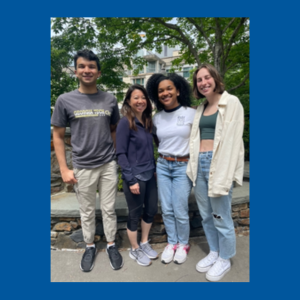Home
Our lab objectives:
- to identify cellular and molecular targets that can be therapeutically exploited to confer radioprotection to the bone
- to elucidate how low oxygen tension in the bone microenvironment contributes to cancer-induced bone pain and metastatic colonization of the bone
Research
People

Publications
Selected Publications
- Utilizing Low Oxygen Tension to Reduce Hematopoietic Cells in Murine Bone Marrow Stromal Cell Cultures. Journal Article J Vis Exp · April 21, 2023
There remains a lack of universally accepted markers to prospectively isolate a homogeneous population of skeletal stem cells (SSCs). For this reason, BMSCs, which support hematopoiesis and contribute to all the functions of the skeleton, continue...Full text
- Hypertrophic chondrocytes serve as a reservoir for marrow-associated skeletal stem and progenitor cells, osteoblasts, and adipocytes during skeletal development. Journal Article Elife · February 18, 2022
Hypertrophic chondrocytes give rise to osteoblasts during skeletal development; however, the process by which these non-mitotic cells make this transition is poorly understood. Prior studies have also suggested that skeletal stem and progenitor cells (SS ...Full text
- Hypoxia depletes contaminating CD45+ hematopoietic cells from murine bone marrow stromal cell (BMSC) cultures: Methods for BMSC culture purification. Journal Article Stem Cell Res · May 2021
Culture-expanded bone marrow stromal cells (BMSCs) are easily isolated, can be grown rapidly en masse, and contain both skeletal stem cells (SSCs) and multipotent mesenchymal progenitors (MMPs). Despite this functional heterogeneity, BMSCs continue to be u ...Full text
- Detection of Hypoxic Regions in the Bone Microenvironment. Journal Article Methods Mol Biol · 2021
Oxygen is a critical environmental factor essential for maintaining the physiological state of a tissue. Hypoxia, or low oxygen, triggers a cascade of events that allows for cells to adapt to low oxygen tensions and to facilitate oxygen delivery re ...Full text
- The Amino Acid Sensor Eif2ak4/GCN2 Is Required for Proliferation of Osteoblast Progenitors in Mice. Journal Article J Bone Miner Res · October 2020
Skeletal stem/progenitor cells (SSPC) are critical regulators of bone homeostasis by providing a continuous supply of osteoblasts throughout life. In response to inductive signals, SSPC proliferates before osteoblast differentiation. Proliferation requires ...Full text
- Micro-environmental Features of the Bone and Bone Marrow Associated with Metastatic Colonization. Conference Journal of Bone and Mineral Research · December 1, 2017 Link
- Suppression of PGC-1α Is Critical for Reprogramming Oxidative Metabolism in Renal Cell Carcinoma. Journal Article Cell Rep · July 7, 2015
Long believed to be a byproduct of malignant transformation, reprogramming of cellular metabolism is now recognized as a driving force in tumorigenesis. In clear cell renal cell carcinoma (ccRCC), frequent activation of HIF signaling induces a metabolic sw ...Full text
- Oxygen-sensing PHDs regulate bone homeostasis through the modulation of osteoprotegerin Journal Article Genes & Development · April 15, 2015
The bone microenvironment comprises niches that house cells across variable oxygen tensions. However, the contribution of oxygen gradients in regulating bone and blood homeostasis remains unknown. Here, we generated mice with either single or ...Full text
- Erratum to Suppression of PGC-1a Is Critical for Reprogramming Oxidative Metabolism in Renal Cell Carcinoma [Cell Reports, 12, 2015, 116-127] Journal Article Cell Reports · January 1, 2015 Full text
- Osteoblasts: A Novel Source of Erythropoietin Journal Article Current Osteoporosis Reports · December 2014 Full text
- PhD Inhibition Mitigates and Protects Against Radiation-Induced Gastrointestinal Toxicity via HIF2 Journal Article Science Translational Medicine · May 14, 2014
Pharmacologic inhibition or knockout of HIF-prolyl hydroxylases in mice reduces morbidity and mortality from radiation-induced gastrointestinal syndrome. ...Full text
- Cross-talk between hypoxia and insulin signaling through Phd3 regulates hepatic glucose and lipid metabolism and ameliorates diabetes Journal Article Nature Medicine · October 2013 Full text
- Regulation of Bone Marrow Angiogenesis by Osteoblasts during Bone Development and Homeostasis Journal Article Frontiers in Endocrinology · 2013 Full text
- The HIF Signaling Pathway in Osteoblasts Directly Modulates Erythropoiesis through the Production of EPO Journal Article Cell · March 2012 Full text
- Aggressive fibromatosis (desmoid tumor) is derived from mesenchymal progenitor cells. Journal Article Cancer Res · October 1, 2010
The cellular origins from which most tumors arise are poorly defined, especially in mesenchymal neoplasms. Aggressive fibromatosis, or desmoid tumor, is a locally invasive soft tissue tumor with mesenchymal characteristics. We found that agg ...Full text
- Side population cells in human cancers. Journal Article Cancer Lett · September 8, 2008
Cancer stem cells (CSCs) are found in multiple tumor types. While surface markers selectively expressed on CSCs are used to isolate these cells, no marker or pattern of makers is known to identify CSCs in many tumor types prospectively. In ...Full text
- The morphogenic function of E-cadherin-mediated adherens junctions in epithelial ovarian carcinoma formation and progression Journal Article Differentiation · February 2008 Full text
- Side population cells isolated from mesenchymal neoplasms have tumor-initiating potential. Journal Article Cancer Res · September 1, 2007
Although tumor-initiating cells maintain many cancers, this has not been shown for mesenchymal tumors, partly due to the lack of unique surface markers that identify mesenchymal progenitors. An alternative technique to isolate stem-like cells is ...Full text
Research Opportunities
The Wu lab seeks motivated graduate students, post-doctoral fellows, and laboratory research assistants to join our lab. Individuals interested in becoming members of our research team should contact Colleen Wu directly.